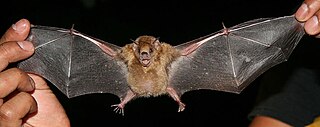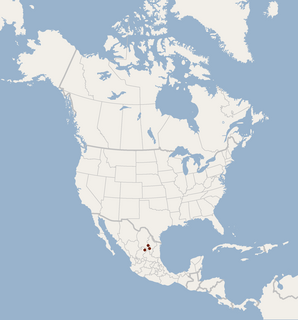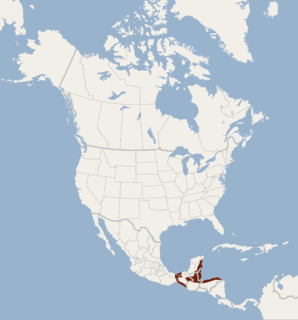
Echolocation, also called bio sonar, is a biological sonar used by several animal species. Echolocating animals emit calls out to the environment and listen to the echoes of those calls that return from various objects near them. They use these echoes to locate and identify the objects. Echolocation is used for navigation, foraging, and hunting in various environments.

The greater bulldog bat or fisherman bat is a species of fishing bat native to Latin America. The bat uses echolocation to detect water ripples made by the fish upon which it preys, then uses the pouch between its legs to scoop the fish up and its sharp claws to catch and cling to it. It is not to be confused with the lesser bulldog bat, which, though belonging to the same genus, merely catches water insects, such as water striders and water beetles.

The New World leaf-nosed bats (Phyllostomidae) are found from southern North America to South America, specifically from the Southwest United States to northern Argentina. They are ecologically the most varied and diverse family within the order Chiroptera. Most species are insectivorous, but the phyllostomid bats include within their number true predatory species and frugivores. For example, the spectral bat, the largest bat in the Americas, eats vertebrate prey, including small, dove-sized birds. Members of this family have evolved to use food groups such as fruit, nectar, pollen, insects, frogs, other bats, and small vertebrates, and in the case of the vampire bats, even blood.

The spectral bat, also called the great false vampire bat or Linnaeus's false vampire bat, is a large, carnivorous leaf-nosed bat found in Mexico, Central America, and South America. It is the only member of the genus Vampyrum; its closest living relative is the big-eared woolly bat. It is the largest bat species in the New World, as well as the largest carnivorous bat: its wingspan is 0.7–1.0 m (2.3–3.3 ft). It has a robust skull and teeth, with which it delivers a powerful bite to kill its prey. Birds are frequent prey items, though it may also consume rodents, insects, and other bats.

The brown long-eared bat or common long-eared bat is a small Eurasian insectivorous bat. It has distinctive ears, long and with a distinctive fold. It is extremely similar to the much rarer grey long-eared bat which was only validated as a distinct species in the 1960s. An adult brown long-eared bat has a body length of 4.5–4.8 cm, a tail of 4.1–4.6 cm, and a forearm length of 4–4.2 cm. The ears are 3.3–3.9 cm in length, and readily distinguish the long-eared bats from most other bat species. They are relatively slow flyers compared to other bat species.

The dwarf dog-faced bat is a species of free-tailed bat from South America. It is found in Argentina, Bolivia, Brazil, Colombia, Ecuador, Guyana, Peru, Paraguay and Uruguay, typically at lower elevations. It is one of two species in the genus Molossops, the other being the rufous dog-faced bat. Three subspecies are often recognized, though mammalogist Judith Eger considers it monotypic with no subspecies. It is a small free-tailed bat, with a forearm length of 28.9–32.5 mm (1.14–1.28 in) and a weight of 5–8 g (0.18–0.28 oz); males are larger than females. It is brown, with paler belly fur and darker back fur. Its wings are unusual for a free-tailed bat, with exceptionally broad wingtips. Additionally, it has low wing loading, meaning that it has a large wing surface area relative to its body weight. Therefore, it flies more similarly to a vesper bat than to other species in its own family. As it forages at night for its insect prey, including moths, beetles, and others, it uses two kinds of frequency-modulated echolocation calls: one type is to navigate in open areas and to search for prey, while the other type is used for navigating in cluttered areas or while approaching a prey item.

The chestnut short-tailed bat is a bat species from South and Central America. The species is often confused with the Benkeith's short-tailed bat. It is a mainly frugivorous species that has been known to consume insects. To determine which pipers to forage on, it focuses on oder and then after proceeds to echolocate to determine position. It hunts between nightfall and midnight. Habitats include hollow trees, caves, cracks, abandoned mines, sewers, and house roofs. It does not decrease activity during full moons, only instances of turbulent weather like heavy rain. In an agricultural setting it has a higher resistance to habitat fragmentation compared to similar bat species.

Seba's short-tailed bat is a common and widespread bat species in the family Phyllostomidae. They are found in Central America, the northern parts of South America, and in the Antilles islands.

The long-legged bat is a member of the Phyllostomidae family in the order Chiroptera. Both males and females of this species are generally small, with wingspans reaching 80mm with an average weight ranging between 6 and 9 grams. The facial structure of these bats includes a shortened rostrum with a prominent noseleaf. The most defining feature of these bats however, is their long posterior limbs that extend farther than most Phyllostomidae bats. At the ends of these hind legs, the long-legged bat has abnormally large feet equipped with strong claws.

Schmidts's big-eared bat is a bat species from South and Central America.

The little yellow-shouldered bat is a bat species from South and Central America. It is a frugivore and an effective seed disperser.

Micronycteris is a genus of leaf-nosed bats.

The flat-headed myotis is a species of vesper bat. It is endemic to Mexico where it is found in certain montane forests in the Sierra Madre Oriental in the northeast of the country. Once thought to be extinct, this bat was rediscovered in 2004 by Joaquín Arroyo-Cabrales and colleagues. The species is now classified as endangered by the IUCN.

The gray short-tailed bat, or Hahn's short-tailed bat, is a species of bat in the family Phyllostomidae native to Mexico and Central America.

Davis's round-eared bat is a species of bat in the family Phyllostomidae. It is found in Belize, Guatemala, Honduras, and southeastern Mexico.

Waterhouse's leaf-nosed bat is a species of big-eared bat in the family Phyllostomidae. It is found in the Cayman Islands, Cuba, the Dominican Republic, Guatemala, Haiti, Jamaica, and Mexico, with a range from Sonora to Hidalgo Mexico, south to Guatemala and the Greater Antilles.

The Cuban fig-eating bat, or white-shouldered bat, is a species of bat in the family Phyllostomidae, found only in the Caribbean. It is the sole extant species in the genus Phyllops, although two other species, P. vetus and P. silvai, are known from fossils.

A nose-leaf, or leaf nose, is an often large, lance-shaped nose, found in bats of the Phyllostomidae, Hipposideridae, and Rhinolophidae families. Because these bats echolocate nasally, this nose-leaf is thought to serve some role in modifying and directing the echolocation call.

Kalko's round-eared bat is a species of leaf-nosed bat endemic to Panama.

Yates's big-eared bat is a species of leaf-nosed bat found in Bolivia.






















